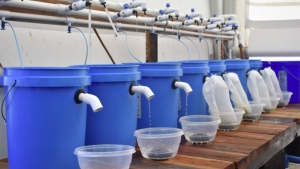
Oysters raised at the Pacific Aquaculture and Coastal Resources Center (PACRC) at the University of Hawaiʻi at Hilo are being used to improve ocean water quality in Māʻalaea Harbor on Maui. The project is headed by Maui Nui Marine Resource Council.
“Oysters are nature’s most efficient water filters; they eat by pumping large volumes of water through their bodies and in the process, they capture sediment and pollutants from the water column,” said Amy Hodges, programs manager at Maui Nui Marine Resource Council. “Our goal is to use the oyster’s natural filter feeding abilities to make Māʻalaea Bay cleaner and healthier for fishing, swimming, paddling and surfing.”
Maui Nui Marine Resource Council is conducting this project in partnership with Oʻahu Waterkeepers, a neighbor island nonprofit.

The first oyster project of this type in Hawaiʻi was launched to restore native oysters to actively improve water quality and clarity at locations around the island of Oʻahu.
More than 10,000 oysters produced at the UH Hilo aquaculture center have been out-planted at the Joint Base Pearl Harbor-Hickam, the Marine Corps Base at Kāneʻohe Bay, the Hawaiʻi Yacht Club and the Waikiki Yacht Club in the Ala Wai Harbor, and most recently at Honolulu Community College’s Marine Education and Training Center at Sand Island.
- Related UH News story: UH Hilo center grows oysters and the aquaculture workforce, March 4, 2018
Hodges explained that the oysters installed in Māʻalaea are Pacific oysters (Crassostrea gigas) which are found throughout the main Hawaiian Islands. After months in the nursery at the university’s aquaculture center, the young oysters are now believed to be large and hardy enough to survive the heavily sedimented waters of Māʻalaea Harbor. The oysters will live in cages below the water surface and away from boat traffic. They were raised triploids, meaning they are sterile and likely unable to reproduce.
For the full story, visit the UH Hilo Stories website.

